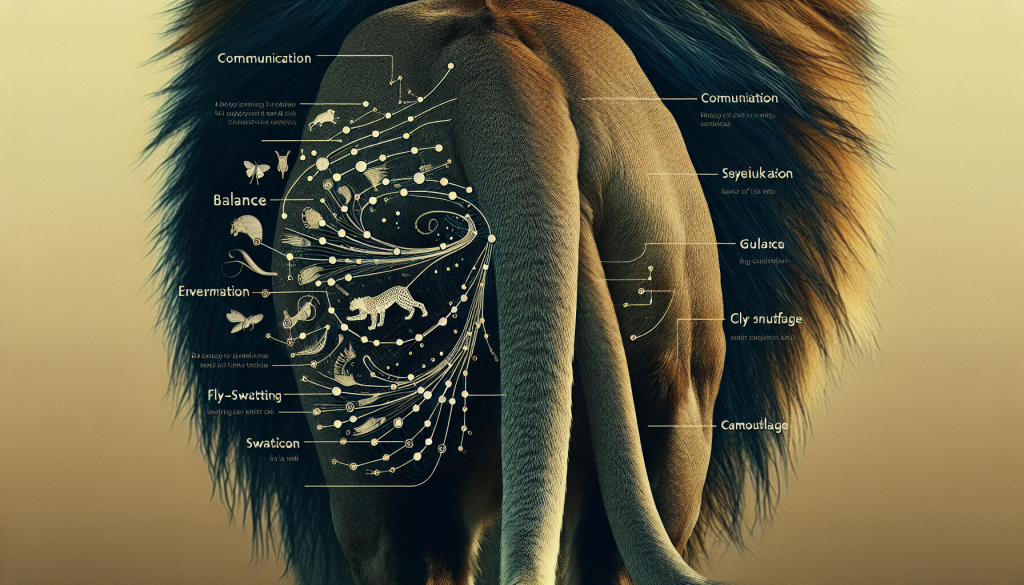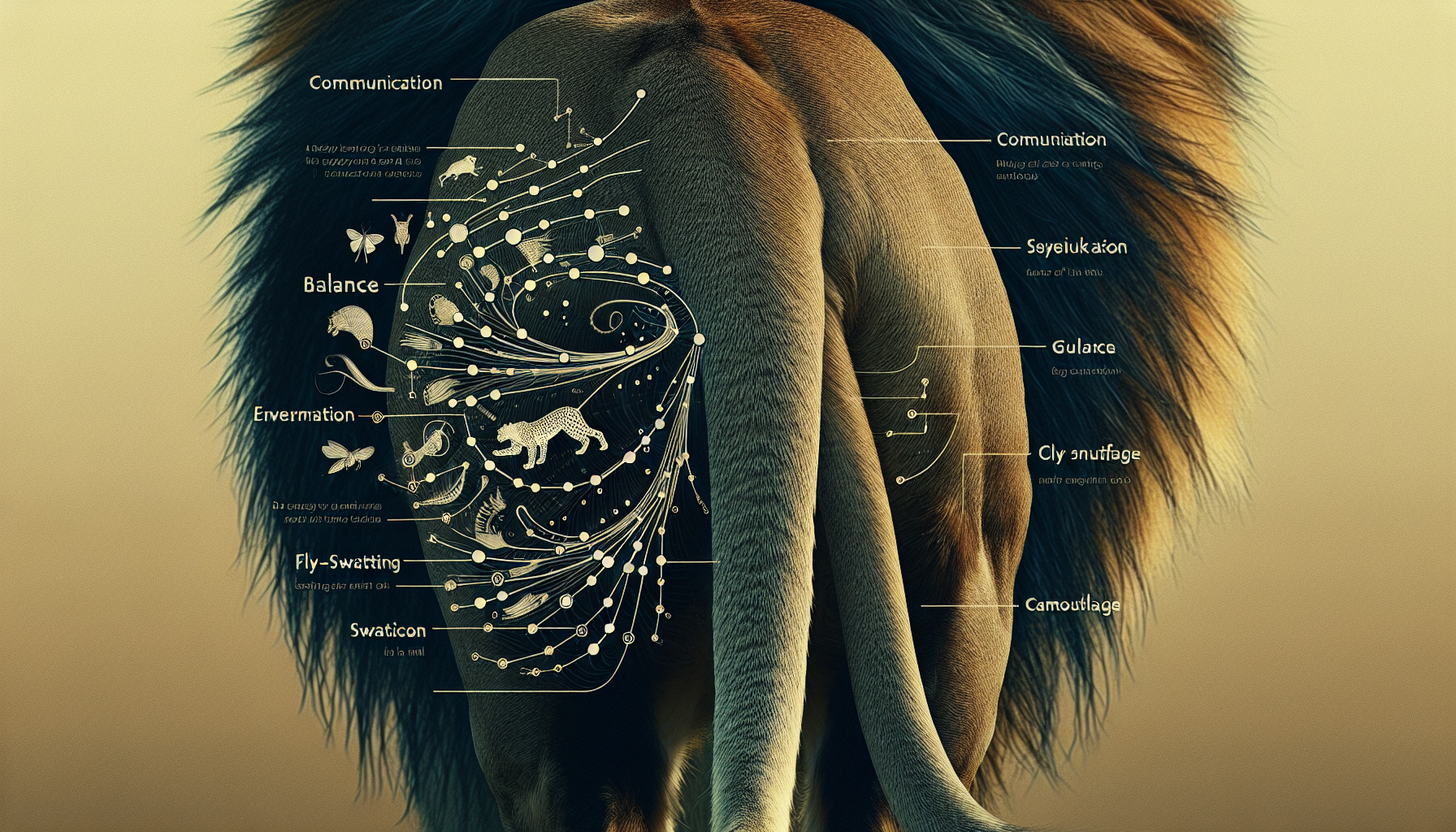Have you ever wondered what a lion’s tail is actually for? It’s not just for show! A lion’s tail serves many important functions that contribute to its survival in the wild. From communication and balance to swatting away annoying insects, the majestic tail of a lion is a fascinating adaptation that plays a crucial role in its everyday life. Let’s explore the intriguing world of a lion’s tail and uncover its secrets.

Evolutionary Purpose of Lion’s Tail
Protection
The lion’s tail serves several important purposes, one of which is protection. Lions are large, powerful predators, and their long tails play a vital role in defending themselves against potential threats. When a lion feels threatened or needs to protect itself or its cubs, it can flick its tail forcefully from side to side. This tail flicking serves as a warning signal, deterring attackers and keeping them at bay. The swift movement of the tail creates a visual barrier, indicating to potential predators that the lion is ready to defend itself.
Social Signaling
Another evolutionary purpose of the lion’s tail is social signaling. Lions are highly social animals that live in prides. Within the pride, communication is crucial for maintaining order and coordinating activities such as hunting and defending territory. Lions use their tails as a means of non-verbal communication, conveying important information to other members of the pride. For example, when a lion flicks its tail slowly and gently, it is an invitation for social interaction or grooming. On the other hand, a fast and abrupt tail movement can signal aggression or dominance.
Physical Features of Lion’s Tail
Length and Weight
The lion’s tail is an impressive appendage, both in terms of its length and weight. On average, a lion’s tail measures around 3 feet in length, making it about half the length of its body. This long tail adds to the overall majestic appearance of the lion and contributes to its iconic image. Despite its length, the lion’s tail is not particularly heavy, weighing only a few pounds. This relatively lightweight allows the lion to move its tail with agility and precision, enhancing its effectiveness in various functions.
Color and Texture
In terms of color and texture, the lion’s tail resembles the rest of its body. The tail is covered in short, coarse fur that matches the lion’s overall tawny coloration. This consistent appearance helps the lion blend in with its surroundings, providing camouflage when hunting or hiding in tall grass. The texture of the tail’s fur also aids in the lion’s tactile communication, as it allows for sensory stimulation when interacting with other lions.
Communication and Signaling
Visual Communication
Visual communication is crucial in the lion’s social dynamics, and the tail plays a significant role in conveying messages to other pride members. By using different tail movements, lions can communicate their emotions, intentions, and social status. For instance, when a lion raises its tail high, it signals confidence and dominance. Conversely, a lower tail position suggests submissiveness or fear. Additionally, the black tuft at the tip of the lion’s tail acts as a visual cue, enabling enhanced visibility and communication among pride members, even in dense vegetation.
Tactile Communication
In addition to visual communication, lions also use their tails for tactile communication. Touching tails is a common gesture among lion pride members, particularly during greetings or bonding moments. When lions touch tails, they exchange scents, which carry crucial information about the individual’s identity, reproductive status, and well-being. This tactile communication enhances social bonds within the pride and contributes to the overall cohesion and cooperation among its members.
Balance and Coordination
Counterbalance during Movement
The lion’s tail plays a vital role in maintaining balance and coordination, especially during agile movements. Lions are incredibly agile creatures, capable of running, turning, and pouncing with remarkable speed and accuracy. The tail functions as a natural counterbalance, enabling the lion to make sudden and swift changes in direction without losing its equilibrium. As the lion twists and turns, the tail acts as a dynamic and flexible extension of its body, providing additional stability and coordination.

Hunting and Prey Capture
Improved Maneuverability
The lion’s tail is instrumental in facilitating hunting and prey capture. When pursuing fast-moving prey, such as gazelles or zebras, the tail helps the lion make quick turns and changes of direction. The swishing and flicking motions of the tail aid in stabilizing the lion’s body during high-speed chases, preventing it from losing balance and reducing the risk of injury. The tail’s ability to counterbalance during rapid movements allows the lion to maintain its focus on the prey, increasing the chances of a successful hunt.
Stalking and Camouflage
The lion’s tail also assists in stalking and camouflage. Lions are adept at hiding and blending in with their surroundings, waiting patiently for the opportune moment to strike. The tail, with its coloration and texture, serves as an effective disguise when the lion is lying in tall grass or dense vegetation. By positioning its tail low and keeping it still, the lion can make itself inconspicuous, allowing for a surprise attack on unsuspecting prey. The tail’s role in camouflage is crucial for ensuring a successful hunt and maximizing the lion’s chances of securing a meal.
Flies and Insect Repellent
Swatting Function
Flies and other insects can be a persistent nuisance to lions, particularly in hot and humid environments. However, the lion’s tail comes to the rescue by serving as a natural flyswatter. The tip of the lion’s tail contains a dense tuft of hair that acts as an effective deterrent against pesky insects. Lions frequently flick their tails back and forth to ward off flies and other pests, creating a breeze and disrupting the insects’ flight. This swatting function not only provides relief for the lion but also helps maintain its overall health and hygiene.
Social and Dominance Displays
Freckling and Tail Flipping
Lions use their tails in various social and dominance displays, particularly during confrontations or territorial disputes. One common display that involves the tail is known as freckling. When a lion is agitated or trying to establish dominance, its tail starts to twitch uncontrollably. These rapid tail movements, resembling a flickering flame, serve as a warning to rival lions or intruders, indicating the lion’s readiness to defend its territory. Additionally, the lion may engage in tail flipping, where it raises its tail high and flips it from side to side. This assertive gesture communicates dominance and asserts the lion’s authority within its social group.
Species Variation
Tail Differences among Lions
While a lion’s tail generally exhibits common characteristics, there can be variations in tail length and appearance among different lion subspecies. For example, the Barbary lion, which is now extinct in the wild, was known to have a notably longer and bushier tail compared to other lion subspecies. Conversely, some Asiatic lion populations have shorter tails, which are believed to be adaptations to their specific environments. These variations in tail characteristics are a result of natural selection and adaptation to different habitats, confirming the tail’s significance in the lion’s survival and success.
Tail Adaptations in Other Animals
Tails Defense Mechanism
The lion is not the only animal that has evolved a tail for various purposes. In the wild, tails are often used as a defense mechanism against predators or as a means of warding off potential threats. For example, the rattlesnake’s tail is equipped with a rattle that produces a distinctive noise, serving as a warning to potential attackers. Similarly, certain monkeys have tails that act as an additional limb for balance, grip, and even as a tool for communication.
Prehensile Tails
Some animals, such as certain species of primates and rodents, have tails with a remarkable adaptation known as prehensility. These tails are highly flexible and capable of grasping objects, resembling another limb. Prehensile tails aid in climbing, reaching food, and even hanging from branches. This incredible adaptation allows these animals to navigate their environment more effectively and access resources that may not be easily reached by other means.
The Lion’s Tail: A Multi-Purpose Tool
Versatility and Importance
In conclusion, the lion’s tail is a multi-purpose tool that serves various functions crucial for the survival and success of the species. From protection and social signaling to balance and coordination, the lion’s tail is an integral part of the lion’s anatomy and behavior. Its length, weight, color, and texture make it an efficient tool for communication, hunting, and defense. Its unique adaptations showcase the complexity of natural selection and evolution. The lion’s tail embodies versatility, importance, and the remarkable adaptations that have helped lions thrive as powerful apex predators in their ecosystems.

